The principle of operation of a dual-circuit gas heating boiler and features of its connection
All issues of organizing autonomous heat supply and hot water preparation are decided by the acquisition of one boiler capable of servicing both systems. Not knowing the principle of operation of a double-circuit gas heating boiler, it would be illogical not only to make a purchase, but also to operate the unit. Do you agree?
We will talk about the operation of the heater, consider all its weaknesses and strengths. Understanding the basis of the equipment, you can easily take advantage of all its advantages. And if necessary, it will turn out in time to identify malfunctions, understand and eliminate the causes of their origin.
The content of the article:
The device of the boiler for servicing two circuits
A double-circuit gas heat generator differs from a single-circuit analogue in that instead of one heat exchanger, it has two, they are called primary and secondary in technical terminology.
The first, i.e. primary heat exchanger located directly in the combustion zone of the flame. Its task is to heat the coolant for the functioning of the heating network. The secondary heat exchanger is responsible for the operation of DHW.
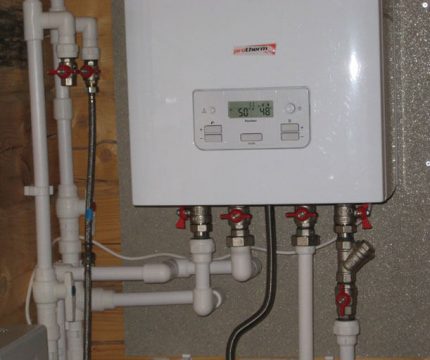
The design of any dual-circuit unit includes the following standard elements:
- Combustion chamber with a burner block;
- Heat exchangers;
- Control devices and equipment protection.
To understand the features of the device of gas boilers of a double-circuit variety, we dwell on each of its structural elements.
Types of gas burners for double-circuit boilers
The burner of the gas boiler is responsible for obtaining a sufficient amount of heat necessary for the functioning of the heating and the hot water supply circuit. Thermal energy is obtained by burning fuel. The burner is placed in a combustion chamber, into which air is pumped in addition to gas. It is needed for the combustion process.
Depending on the operating conditions, the burners can be classified into the following types:
- Single level burner. A unit with a similar burner can operate in only two modes - “Stop” and “Start”. Such boilers, despite the low efficiency and reduced service life, are popular due to the simplicity of design and low cost.
- Two-level burner. A heater with such a burner can operate at full and half power. Its advantages are noticeable in the warm season, when there is no need to operate the device at full power to heat not too cold water.
- Modulating burner. A smart boiler system with a similar burner allows you to configure and adjust the power. Such a boiler is characterized by a high service life and efficiency, but at the same time it is an order of magnitude higher than units with single-level and two-level burners.
Burners are divided into designs of open and closed type. When the burner is open, the air necessary for burning fuel comes directly from the room in which the boiler is located. For the removal of combustion products, a chimney is required, which should provide sufficient natural draft.
Atmospheric heating units are equipped, as a rule, with an ordinary metal pipe, turbine ones with a coaxial chimney. Depending on the technical conditions of the room, the smoke channel is placed vertically or built at an angle. Corner options are led out through the wall to the street or connected to a public chimney shaft.
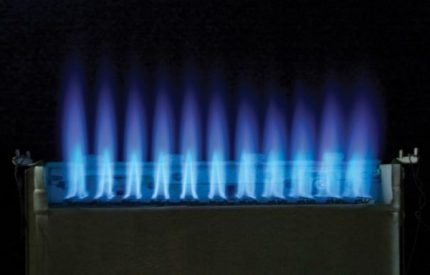
Turbine boilers are equipped with closed combustion chambers, into which air cannot flow spontaneously. They are safer and more reliable in operation, but more expensive and more difficult to operate. Boilers with closed burners, in addition to the chimney, need a channel through which the oxygen required for combustion is supplied to the chamber.
Therefore, turbine boilers are equipped coaxial tubes, because in addition to exhausting smoke, they also draw in fresh air from the street. It happens that for normal operation two coaxial flues are connected to a closed combustion chamber. In addition, the entire structure is supplemented by an air supply pipe.
All such boiler models are equipped with fans providing smoke movement, multi-level protection systems, and automation. For the operation of the listed devices and systems, electricity is needed. Their minus is energy volatility, which increases operating costs.
Varieties of gas unit heat exchangers
If a fuel is burned with the aid of a burner in order to obtain heat, then the heat exchanger provides this heat for further transfer to water. As already mentioned, the primary and secondary heat exchangers are present in the dual-circuit design.
The primary heat exchanger is located directly above the burner and is a finned tube curved in the form of a snake. Under the action of a flame, the water in the heat exchanger heats up and moves through a three-way valve further to the wiring heating system.
The secondary heat exchanger is a system of corrugated plates, which are assembled in a single unit with two pairs of holes. Each pair of holes has its own functions.
Water flows from the water supply pipe through one of the pairs, and the coolant entering the heating circuit moves through the second.A similar system of plate and tubular heat exchangers is called dual.
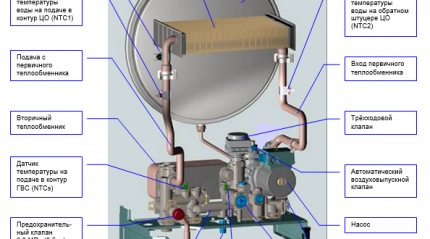
There are heating appliances in which a bithermic heat exchanger of a complex configuration is used instead of a dual system. Such a heat exchanger is made of copper, it is a pair of tubes located one in the other. The coolant moves through the outer tube, and water through the inner tube to ensure the operation of the hot water supply.
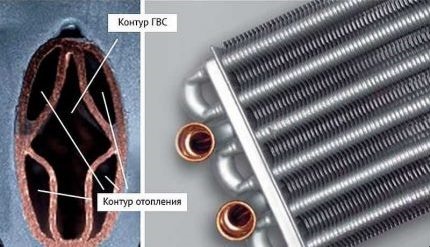
Boilers with a bithermic heat exchanger are more difficult to operate, since both heat exchangers are represented by a single unit, which makes it difficult to clean it from scale. But such heating devices are in demand, as they differ in small overall dimensions and high speed of heating water.
Automation or boiler control unit
The boiler automation is responsible for safe and stable operation. It monitors the temperature of the water in the components of the hot water supply, maintains the temperature of the coolant in the heat supply lines. Gas boiler automation does not allow the operation of the heater in case of dangerous situations.
The unit interrupts work or does not turn on in such cases:
- Reduced pressure in the gas system;
- Lack of traction;
- Absence or critical coolant overheating.
The control unit that controls the operation of protection and process automation devices is represented by a set of switches, microcircuits, or a combination thereof. In addition to ensuring safety and temperature control, he monitors the operation of the circulation pump and fan.
Modern gas boilers are distinguished by the presence of intelligent control, in the software of which there are various operating modes.
Principle of work and specifics
Many owners of gas equipment do not even think about how a double-circuit gas boiler actually works. They mistakenly believe that heating of water and the heating circuit occurs simultaneously. In fact, everything does not look so rosy.
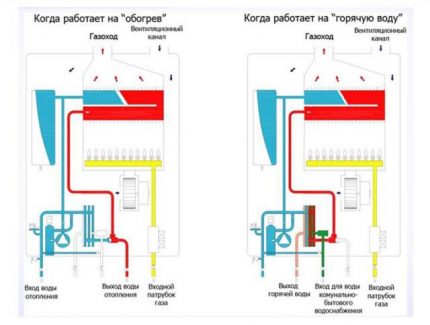
In normal mode, the boiler constantly works only to heat the coolant circulating in the system. In this case, the switching frequency and the intensity of the flame are controlled by a temperature sensor. At the same time the burner starts circulation pumpif the action of the heating system is not based on the natural circulation of the coolant.
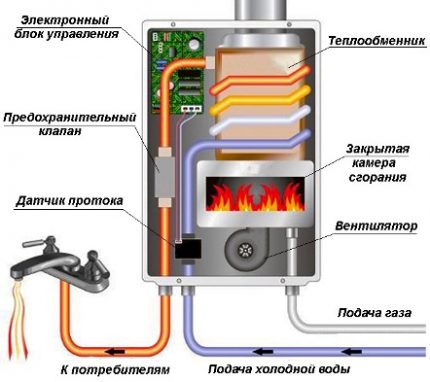
In fact, when the temperature of the coolant reaches a predetermined value, the sensor sends a signal indicating a decrease in burner activity. Until the temperature drops to the set value, the boiler will be in passive mode. Then again the command from the sensor to the automation to activate the fuel supply valve.
Double-circuit boiler operation scheme
The presence of a hot water supply system slightly complicates the operation scheme of a double-circuit gas boiler. Heated by burner coolantmoving along the heat exchanger, it heats the plate heat exchanger through which water moves from the water supply.
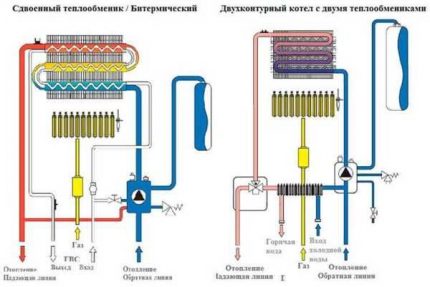
The simultaneous use of a dual-circuit model in heating and hot water mode is not possible. When the hot water tap is activated, due to the three-way thermostatic valve, the circulation of the coolant along the heating mains stops. The boiler enters the mode of moving water along the circuit with a plate heat exchanger, which is used to heat water for domestic purposes.
With a significant consumption of hot water for a long time, the operation of the boiler with a focus on heating can be paralyzed. There are two ways to solve the problem - to provide for the installation of a more powerful heating device or to include it in the arrangement indirect heating boiler.
With the active use of the DHW system, it is possible to install a dual-circuit boiler with a built-in boiler. In this case, the fuel consumption is slightly increased due to the fact that in the pause between the cycles of the heating system, the burner energy is used to maintain the water temperature in the additional gas water heater.
A certain supply of hot water in the built-in boiler allows you to use the DHW system without disconnecting the heating circuit. As a result, both systems operate alternately, with no overheating of the liquid and extending the life of the heat exchanger.
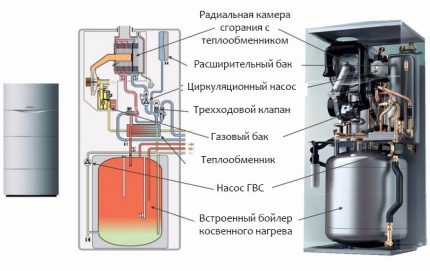
The built-in standard boiler allows you to get hot water at the right temperature at any time, the supply of which is provided in automatic mode. While the DHW flow system takes several minutes to heat water to the required temperature.
Types of execution of gas boilers for two circuits
Features of the gas equipment is largely determined by the embodiment of the heater. Modern boilers are available in two form factors - floor and wall.
When choosing a design option, you need to focus on the size of the heated area, the activity of using the DHW system. You need to understand that wall-mounted boilers are more compact, but at the same time they have much less power.
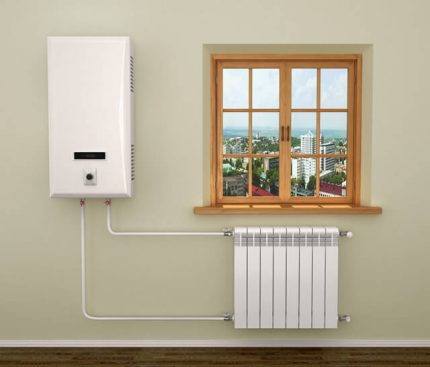
The choice wall-mounted double-circuit boiler may be justified if the heated area does not exceed 200 sq. m, and the total capacity of the hot water system is not more than 14 l / min.
The small dimensions of the wall-mounted boiler, although it seems a virtue, in fact hide a lot of minuses. Compactness is achieved through the use of thinner heat exchanger tubes. Besides the fact that they have a shorter service life, there is a possibility of their clogging.
In floor installations, more massive and reliable cast iron heat exchangers are used. This not only increases the degree of reliability of the heater, but also extends its service life.
Advantages and disadvantages of dual-circuit devices
The advantages of a dual-circuit heating unit are as follows:
- Economical fuel consumption. The direction for comparison is the use of a dual-circuit boiler or a single-circuit boiler with indirect heating.
- Compact size. The overwhelming majority of double-circuit boilers are represented by wall-mounted heating devices. They are easy to place both in the utility rooms and in the small-sized kitchen.
- Universality. There is no need to buy additional equipment and solve issues with its compatibility with the boiler.
In one unit, a flowing water heater, a heating device and a circulation pump are already successfully combined into a single automated system.
Obviously, along with the advantages, there are also disadvantages:
- The impossibility of the simultaneous action of heating and the DHW circuit. In this regard, a significant consumption of hot water can cause a decrease in temperature in the house.
- Power limitations of wall models. Compact wall-mounted boilers, due to the minimum size of the burner, are not able to provide the required temperature conditions at maximum pressure. A similar drawback is observed with the remote placement of water intake points.
- Sensitivity to water quality. The secondary plate heat exchanger is demanding on the quality of the consumed water. The presence of impurities becomes the reason for the use of means to reduce its rigidity, and to conduct cleaning of the coolant.
Another criterion for evaluating a dual-circuit boiler is its cost. The price of a dual-circuit heater is higher than the price of a single-circuit analog.
However, if we consider the availability of a hot water supply system and ways to resolve the issue in the case of installing a single-circuit boiler, then when the indirect heating boiler is included in the assembly circuit, the price of the double-circuit will be lower.
Conclusions and useful video on the topic
The following video will familiarize with the structural components and the principle of operation of gas heating equipment:
The piping of a double-circuit gas boiler will be presented by the author of the video:
A detailed acquaintance with the features and the principle of operation of dual-circuit gas units makes it possible to determine the advantages of their operation. The purchase of such heaters will help to save on the purchase of additional equipment necessary for the organization of a hot water supply system.
If one of the circuits breaks down, the operation of the other is possible, and replacing the circuit will always be cheaper than repairing a separate heating installation. A double-circuit boiler can also be used in the warm season, operating it only in the mode of heating water for domestic needs, which is the convenience and cost-effectiveness in comparison with the purchase of individual units.
Tell us about how to choose a dual-circuit gas boiler for arranging your own house / apartment / cottage. What has become the decisive criterion for you in your choice? Please share useful information on the topic, photos in the block below, ask questions.

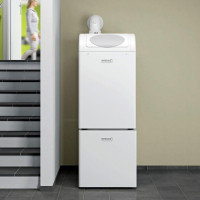 Rules for connecting a dual-circuit gas boiler to gas
Rules for connecting a dual-circuit gas boiler to gas 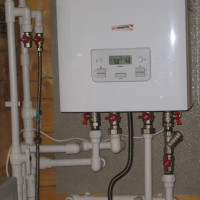 Connecting a double-circuit gas boiler to the heating system: requirements and norms + installation steps
Connecting a double-circuit gas boiler to the heating system: requirements and norms + installation steps  Gas generator for a gas boiler: specifics of choice and features of connection
Gas generator for a gas boiler: specifics of choice and features of connection 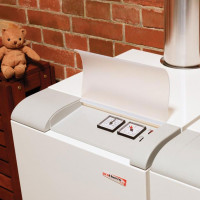 Installation of a gas boiler Protherm: features and main stages of installation + wiring diagrams
Installation of a gas boiler Protherm: features and main stages of installation + wiring diagrams 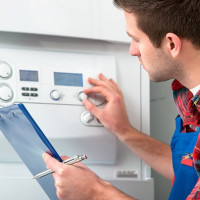 Adjustment of gas boiler automation: device, principle of operation, tuning tips
Adjustment of gas boiler automation: device, principle of operation, tuning tips 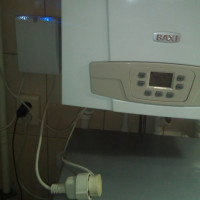 Gas boiler power consumption: how much electricity is needed to operate standard equipment
Gas boiler power consumption: how much electricity is needed to operate standard equipment  How much does it cost to connect gas to a private house: the price of organizing gas supply
How much does it cost to connect gas to a private house: the price of organizing gas supply  The best washing machines with dryer: model rating and customer tips
The best washing machines with dryer: model rating and customer tips  What is the color temperature of light and the nuances of choosing the temperature of the lamps to suit your needs
What is the color temperature of light and the nuances of choosing the temperature of the lamps to suit your needs  Replacement of a geyser in an apartment: replacement paperwork + basic norms and requirements
Replacement of a geyser in an apartment: replacement paperwork + basic norms and requirements